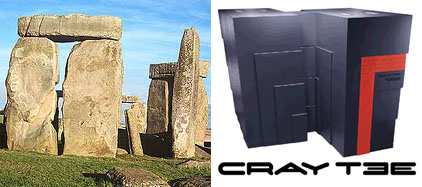Perhaps the most famous of Hyperborean mainframes are the famous Stonehenge monoliths, described by Sicilus as a "huge, round temple" for worshipping Apollo, the sun god. "The remains of this once glorious supercomputer cause us to ask almost as many questions as we can answer," says Dr.Tunalu.
To the naive observer, perhaps the first impression is of the many physical similarities between Stonehenge and a twentieth century supercomputer (see illustration).

Perhaps the most fundamental question is "how was this system powered?"
It is obvious that the Hyperboreans did not use solar power, as the weather in this part of the world is not conducive to the manufacture of an efficient solar cell. It is also obvious that they did not use wind power, as the massive structures required for such an undertaking would surely have survived.
Perhaps the most significant clues are the series of "post holes" in the ground, nearby the great stone CPUs. It is Dr. Tunalu's belief that these holes were in reality the ports of entry for great hempen or leather conduits that fed power from an underground volcanic source. Unfortunately, these softer materials have not survived the ravages of time.
It is assumed that, like all ancient British systems found thus far, the memory units were constructed almost entirely of wood, using the trunk of the beech tree as the basic indivisable unit of memory. See the section on rod memory for a more detailed explanation of the principles involved.
The main difference between the classic neolithic mainframes and the more modern Celtic machines was their sheer size. The Hyperborean mainframes used entire tree trunks for the basic unit of memory, whereas the Druids (ostensibly for reasons of secrecy) embarked on a miniaturization programme which reduced the size of the basic memory unit to a stick, or "rod." However, the basic abstract units of memory, the "gyte" and the "fagyte," remained the same, indicating that at least some of the Iberian software was likely compatible with the Druidic machines, once converted to the right medium.
Although the most famous, Stonehenge was not the largest Hyperborean mainframe. This mammoth machine was located at the Hyperborean's Biosphere III site.
Photography by Cliff Wassmann and Cray Research.